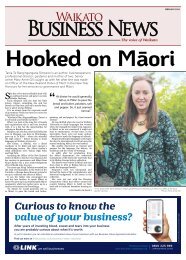Waikato Business News April/May 2019
Waikato Business News has for a quarter of a century been the voice of the region’s business community, a business community with a very real commitment to innovation and an ethos of co-operation.
Waikato Business News has for a quarter of a century been the voice of the region’s business community, a business community with a very real commitment to innovation and an ethos of co-operation.
Create successful ePaper yourself
Turn your PDF publications into a flip-book with our unique Google optimized e-Paper software.
WAIKATO BUSINESS NEWS <strong>April</strong>/<strong>May</strong> <strong>2019</strong><br />
15<br />
A general manager’s bad marketing maths<br />
It’s interesting that sometimes bad maths<br />
sounds completely logical, even to highly<br />
experienced senior managers.<br />
Some time ago I met with<br />
a general manager of a<br />
small division within a<br />
larger company. His division<br />
had a strong focus on sales but<br />
very little investment in marketing.<br />
They had a solid client base<br />
and very high margins, so were<br />
strongly profitable.<br />
While sitting in his office,<br />
discussing a potential marketing<br />
campaign, he explained to<br />
me: “I have target annual revenue<br />
of $1 million and a marketing<br />
budget of $50,000. So,<br />
every dollar spent on marketing<br />
must directly bring in $20, otherwise<br />
it doesn’t make sense to<br />
do it”.<br />
At first, it sounds logical.<br />
His revenue target of $1 million<br />
is 20 times the size of his<br />
marketing budget of $50,000.<br />
Therefore, every dollar spent<br />
on marketing needs to produce<br />
$20.<br />
Extrapolating the logic, we<br />
can say that if he spent money<br />
on marketing that only produced<br />
$7 for every $1 of ad<br />
spend, with the $50,000 marketing<br />
budget he would only<br />
expect to earn $350,000 revenue<br />
for the year, which would<br />
be a disaster.<br />
However, this is an example<br />
of bad marketing maths, which<br />
was severely restricting the<br />
business growth.<br />
His logic failed because<br />
most of their sales each year<br />
came from repeat customers,<br />
not from advertising. They had<br />
excellent email engagement<br />
with existing clients that drove<br />
sales, as well as two highly<br />
dedicated sales reps on the road<br />
visiting their clients throughout<br />
the year.<br />
The truth is that even if he<br />
spent nothing on marketing for<br />
the whole year, they could still<br />
expect to have substantial sales<br />
from their repeat customers.<br />
So then, if business is so<br />
good, why advertise at all?<br />
For this business, the purpose<br />
of advertising was to<br />
attract new customers, who<br />
would turn into repeat customers.<br />
Better marketing maths<br />
would start by asking what percentage<br />
of their revenue was<br />
expected from new customers<br />
each year. For this division,<br />
because of their strong repeat<br />
sales, just 20 percent of their<br />
revenue was expected to come<br />
from new customers.<br />
This changes the maths significantly.<br />
The $50,000 marketing<br />
budget is actually aiming to<br />
produce $200,000 of new revenue.<br />
This means every marketing<br />
dollar spent needs to bring<br />
in a more realistic $4 to be profitable.<br />
This makes finding profitable<br />
marketing opportunities<br />
far more likely.<br />
With the previous unrealistic<br />
20x return-on-investment<br />
requirement the general manager<br />
was turning down many<br />
good advertising opportunities<br />
that could have easily brought<br />
in new clients. The result was<br />
that the marketing budget was<br />
underspent (since very few<br />
campaigns could come close<br />
to meeting the performance<br />
requirement) and the targets<br />
for annual revenue from new<br />
clients weren’t met, which<br />
affected their revenues overall.<br />
Had he used better marketing<br />
maths, advertising campaigns<br />
would have been placed<br />
more often giving the sales team<br />
fresh leads and the revenue target<br />
for new customers could<br />
easily have been achieved.<br />
There’s another, even a better<br />
way, that the general manager<br />
could have approached the<br />
marketing maths. It starts by<br />
THE DIGITAL WORLD<br />
> BY JOSH MOORE<br />
Josh Moore is the head marketing fanatic at Duoplus, a<br />
Hamilton-based digital marketing agency that helps clients<br />
across NZ grow faster. www.duoplus.nz<br />
asking, “How much is a customer<br />
worth?”<br />
For this business, the average<br />
customer was worth $1650<br />
in revenue per year. They had<br />
high gross margins of around<br />
85 percent, meaning a gross<br />
margin per year of around<br />
$1400 per customer. The average<br />
lifetime of a customer was<br />
more than 10 years, so each<br />
new customer was worth on<br />
average $14,000 gross profit<br />
over their lifetime.<br />
With these figures, the<br />
general manager could have<br />
decided that he was willing to<br />
spend $350 to acquire a new<br />
client. (He could have chosen<br />
any other figure, but for this<br />
illustration we’ll use $350,<br />
which equates to three months<br />
of profit from the average client).<br />
If we spend the $50,000<br />
marketing budget acquiring<br />
new customers for $350 each,<br />
we are targeting 142 new customers<br />
for the year.<br />
With the same average revenue<br />
of $1650 per annum, these<br />
new customers will bring in just<br />
under $235,000 of revenue for<br />
the year.<br />
But the real return on<br />
investment is seen in the lifetime<br />
value of these new customers<br />
– 142 new customers<br />
are expected to be worth $2m<br />
in gross profit over the next<br />
10 years. This shows the real<br />
benefit that investing in marketing<br />
would bring. Investing in<br />
acquiring new customers now,<br />
would set up profit for many<br />
years to come.<br />
If he wanted to be more<br />
aggressive with acquiring new<br />
customers, he could choose to<br />
increase the marketing budget<br />
and increase what he is willing<br />
to spend to acquire a new customer.<br />
Since a new customer is<br />
worth $14,000 over a lifetime,<br />
spending $700 or even $1400 to<br />
acquire a customer will still give<br />
strong return on investment. It<br />
all depends on the nature of the<br />
industry, the aggressiveness of<br />
the competition and whether<br />
business cashflow allows it.<br />
Bad marketing maths caused<br />
this general manager to be so<br />
restrictive on marketing campaigns<br />
that he was decreasing<br />
profits for many years into the<br />
future. Instead, using good marketing<br />
maths, businesses with<br />
strong repeat business should<br />
look at the lifetime value of<br />
their clients and invest in customer<br />
acquisition that will grow<br />
their customer base and build<br />
business profits for many years<br />
to come.<br />
11 SEPTEMBER <strong>2019</strong><br />
Claudelands | Hamilton<br />
BOOK NOW<br />
Don’t spend<br />
money on<br />
marketing…<br />
unless you really know where it will take you<br />
MORE THAN $1M<br />
OF BUSINESS<br />
GENERATED FROM<br />
THE 2018 EXPO<br />
It’s easy to be tempted<br />
by the latest gizmos or<br />
by what sounds like a great<br />
media discount. But without<br />
a clear direction, you could<br />
be travelling the wrong path.<br />
Do you need to step back and<br />
reassess if your brand looks and<br />
feels right for your business?<br />
Do your marketing activities<br />
genuinely fit with your goals or<br />
your changing marketplace?<br />
If you have any doubts that your brand or marketing strategies<br />
are right for your business, let’s get you back on track.<br />
BOOK YOUR STAND TODAY<br />
Showcase your business | Seminars and masterclasses to grow your business<br />
Create opportunities and uncover solutions | Kick-start your pipeline<br />
Network with leading edge businesses | Amazing Expo only offers and prizes<br />
Free entry for visitors (9.30am - 4pm) | Supercharged one day event<br />
A common-sense approach<br />
to building your brand and<br />
telling your story.<br />
dugmorejones.co.nz<br />
ORGANISERS<br />
HOSTED BY<br />
SPONSORS<br />
For more info : www.businessexpo.biz<br />
m. 0274 896 151<br />
vicki@dugmorejones.co.nz


















